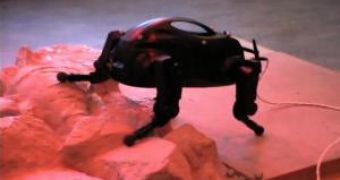A new breed of dogs could someday be sent to Mars to explore the surface, although they are now just barely learning to walk, climb rocks and jump. These robotic dogs are funny-looking robots, but could become more versatile than current rovers.
Robotic probes are used in space exploration for some time now, like the two Mars Exploration Rovers, Mars Spirit and Opportunity. All of them have four to eight wheels or rubber treads. Now a new concept developed by University of Southern California roboticist Stefan Schaal is exploring a new type of locomotion: feet.
Robots that walk on feet, from four to a dozen, have been developed in the past, but most of them were only able to walk on smooth surfaces where wheels are a more efficient way of getting around. Boston Dynamics handles the new project, with a $1.5 million DARPA contract to train new robot dogs in rough terrain.
"What you really want legged robots for is to negotiate difficult terrain," said Schaal. "This project is designed to push that envelop." Continuously aware of its center of gravity, the robot is designed "to adjust a smooth walking pattern generator with the selection of every foot placement such that the center of gravity ? follows a stable trajectory."
In other words, it will be able to climb slopes and rocks and possibly even jump. The new dogs are the size of toy poodles, with four pointy feet ending in little balls and are now learning how to adjust to new environments. Future applications of these robots could even be sent to the Moon or Mars, for geological explorations or even to assist human crews.
Unfortunately, these dogs are more similar to snails, judging from their "impressive" speeds of 1.6 centimeters a second, a little faster than the old 1.2 cm/sec of the old Mars Sojourner robot, the first space exploration rover to successfully reach another planet.
If the project succeeds in doubling or tripling the speed of these robots, the programming will move over into bigger mechanical dogs. Asked if these dogs also bark, Schaal answered that "Once they can run, I'll bark for them," although no one will hear them on Mars or on the Moon, due to the lack of atmosphere.

 14 DAY TRIAL //
14 DAY TRIAL //